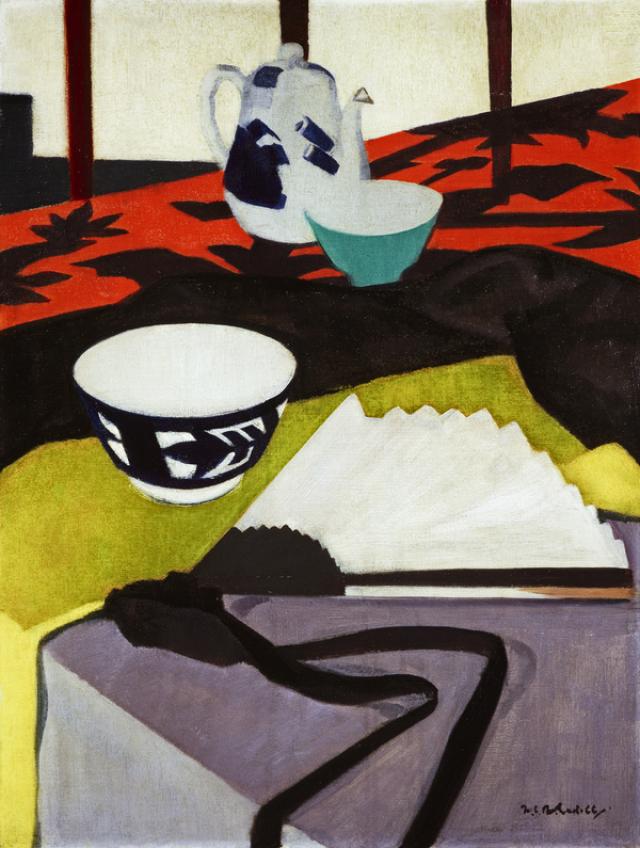Still life
A painting, drawing or photograph depicting inanimate, everyday objects. Although the genre has been in existence since ancient times, it was popularised in Holland after the Renaissance in the sixteenth century and has continued to be explored in contemporary times.

Early Still Life Paintings
The still life genre has existed for thousands of years and is still going strong today. Some of the earliest examples of still life paintings were made in fifteenth century BC by the Ancient Egyptians, discovered in ancient burial sites as funerary paintings depicting meat, fish and grains which would be carried over into the afterlife or made as offerings to the Gods. In ancient Greece and Rome similar subjects appeared in frescoes and as patterned mosaics, referred to as ‘emblema’, acting as symbols of prosperity and wealth in the homes of the upper classes. As the still life genre developed over the centuries it became closely intertwined with religious symbolism, where inanimate objects were often illustrated alongside sacred texts and manuscripts.
Still Life in the Northern Renaissance
It is thought that Italian Early Renaissance painter Jacopo de Barbari made the first still life panel painting in 1504, but it was not until the seventeenth century in Northern Europe that the genre fully came into its own. The term ‘still life’ was derived from the Dutch word 'stilleven', with Dutch and Flemish painters depicting various subjects including dead game, meat, bread and decadent, blooming vases of flowers. In the seemingly simple subject, artists found they could demonstrate a surprising array of virtuoso skill, capturing a wide array of surfaces and textures along with light, form and space. Some of the most lively, outstanding examples were made by Jan Brueghel and Jan van Huysum.
During this time and into the Dutch Golden Age of the seventeenth and eighteenth century, the ‘vanitas’ genre was popular with artists, a complex subject in which artists could combine religious iconography with various memento mori symbols such as burning candles, drying fruit, flowers and skulls, as well as symbols of indulgence, such as wine, food and books, referencing the superficial and fleeting ‘vanities’ of daily life. Such paintings were hugely influential across Europe, with similar idea appearing in the work of Scottish artists William Gouw Ferguson and Richard Waitt. In France, flower painting was a popular subject in the eighteenth century, exemplified in the paintings of Jean-Baptiste Siméon Chardin.
Spanish Bodegones
In Spain, still life subject matter also emerged during the Renaissance period, with artists elevating what was once seen as a humble, inferior subject to the same ranks as Biblical or narrative painting through vivid colour, minute attention to detail and dramatic lighting. The term ‘bodegón’ (Spanish for a storeroom or tavern) was adopted to describe the popularity for the representation of edible items, such as piles of fruit, fish, eggs, bread or game birds alongside objects and utensils including shiny cooking tools, woven bags, clear jars and books. Such a vast array of subjects became a hugely challenging platform for artists to showcase their talents. Many artists, such as Diego Velázquez, were keen to celebrate the importance of everyday items and the honest workers associated with them, as seen in his Old Woman Cooking Eggs, 1618, which combines still life and portraiture genres into a single image.
Nineteenth to Twenty-first Century Still Life
Throughout the nineteenth and twentieth-century, artists continued to explore still life subjects in a range of styles. Realist, Impressionist and Post-Impressionist painters explored ways of adding weight and substance to ordinary items from daily life as a means of celebrating simplicity and honesty over pomp and ceremony, as seen in Edouard Manet’s dark, brooding studies and Glasgow boy William York Macgregor’s lavish The Vegetable Stall, 1884.
Towards the end of the nineteenth century still life became more of a backdrop with which artists could explore aspects of stylisation, exaggeration and abstraction. Scottish Colourist Francis Campbell Boileau Cadell made vibrant, flattened studies of studio arrangements as influenced by Oriental prints, while Paul Cézanne’s close studies of fruit broke the simple subject up into a series of complex, faceted geometric planes. In the twentieth century, Pablo Picasso and Georges Braque took Cézanne’s blocky, geometric brushstrokes closer to abstraction; simple still life subjects in muted colours gave them greater freedom to explore formal and spatial distortions, as seen in Picasso’s Guitar, bec a gaz, flacon (Guitar, Gas-jet and Bottle), 1913. Picasso later expanded the still life genre into three dimensions with his assemblage sculptures.
Italian artist Giorgio Morandi spent most of his career in the twentieth-century painting elegant, pared down studies of bottles and jars, simplified into near Minimalist designs, which came closer to abstraction towards the end of his life in the 1960s, as seen in Natura Morta (Still Life), 1962. Throughout the 1960s, Pop artists depicted simple everyday items as a reflection on growing consumerist and materialist culture, such as Andy Warhol’s famous Campbell’s soup cans, as well as Richard Hamilton’s Desk, 1964. Photorealist artists captured seemingly banal subjects with a knowing, deadpan style, observing minute attention to detail and much like Velásquez, elevating humble subjects to the status of fine art.
Contemporary Examples
In contemporary art still life subjects continue to prove popular, particularly in painting and photography. As with the artists of the past, the portrayal of everyday items is often loaded with symbolism or conceptual content. Audrey Flack’s Photorealist paintings revived the vanitas genre for a new generation by incorporating objects from contemporary life, while Robert Therrien’s reworking of ordinary household items as photographs, prints and sculptures reveal the endlessly recyclable language of still life.













